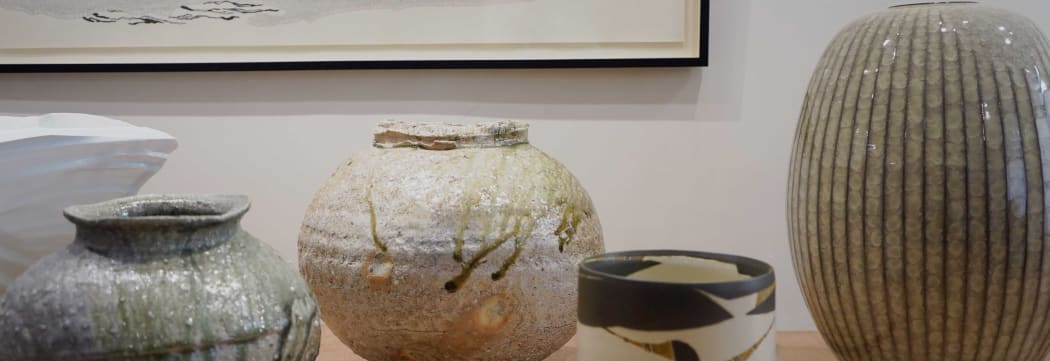
The phonetic term tsubo has two meanings – one is a storage vessel (壷) and the second is the Japanese measure of an area (ツボ). There is something symbolic in this pun in that this exhibition covers the vast area of the various forms a tsubo can take. But puns aside, the “tsubo” is the grand old Japanese ceramic form that defines a vessel or urn that was originally used for storage, and in more recent times expresses a commodious shape, generous proportions and appealing form. The written character tsubo derives from the ancient Chinese hu 壺, a wine storage vessel.
There is a breadth of artistic impulses and traditions in the works in this exhibition. They range from the classics by Tsujimura Shiro (b. 1947), Morino Taimei (b. 1934), Wada Morihiro (1944-2008) and Hoshino Satoru (b. 1945) to the ‘youthful’ works of veritable ‘late comers’ such as Nishibu Isao (b. 1948) and Shimizu Yasutaka (b. 1947). It is easy to appreciate the skill, individuality and creativity of contemporary Japanese ceramics but it's often forgotten that these characteristics are born from many years of determination, commitment and practice on the part of the potter. It strikes one as contradictory that Japan’s famous ‘contemporary’ potters are all well into the age of being grandparents but this merely reflects the commitment these potters have made to their craft and the effort required to gain a seemingly silent mastery.
Nonetheless, these potters grow out of a rich tradition that continues to inspire and lead. The elegant minimalism of the Sue ware jar and the marvellous Muromachi period Shigaraki flower jar in the exhibition are prime examples of just what there is to draw upon. Its ‘skyscape’ of keshiki and ash glaze re-appears five hundred years later in the jar of the Shigaraki master Furutani Michio (1946-2000), sadly no longer with us, but the progenitor of Shigaraki classics during his life. This work also links to the nearly spherical form by Tsujimura Shiro in the exhibition. Widely regarded as one of the most original potters in Japan today, Tsujimura Shiro expresses himself through works deriving from a limited number of traditions, Shigaraki stoneware being but one of these types. He in turn has passed these venerable traditions to his two sons who have chosen to follow in their father’s footsteps. The elder son, Tsujimura Yui (b. 1975), is represented by one of his superlatively ash-glazed pots where the natural fusion of the ash glaze and the clay create a surface landscape of infinite variation. The other potter drawing on the Shigaraki tradition is the self-taught Kohara Yasuhiro (b. 1954). He too uses ash glaze to great effect and achieves an abstraction with it that gives his work a real sense of individuality. Indeed, his use of kiln effects in combination with the ash glaze creates surfaces of great complexity that will suggest its story long into the future.
Any assessment of Japanese ceramics without mention of contemporary Kyoto wares would be sorely missing. This exhibition contains work by four artists that originate from Kyoto. Wada Morihiro trained in Kyoto under Tomimoto Kenkichi (1886-1963) and then moved north of Tokyo to Kasama City where he set up his kiln. Highly successful in Japan he is considered one of the inheritors of the decorative tradition created by Kamoda Shoji (1933-19823). He created his own language to describe his pots and the one in this exhibition roughly translates as ‘reamed-pattern design vessel’, a reference to the black inlay pattern that resembles reamed traces on a piece of metal. Wada’s work demonstrated not only original pattern making – an approach no doubt influenced by Tomimoto Kenkichi – but also highly original forms. He truly was one of the great ceramicists of modern Japan.
Interestingly Morino (Hiroaki) Taimei was also trained by Tomimoto Kenkichi and pattern features strongly in his work as well. His coil- -built pots, original forms in themselves, come into their own with his highly original decoration. A brief period in the United States exposed him to abstract expressionism and his glazing often reflects this influence. Indeed, he moves from nature as an inspirational force to create pots whose colour and form express a highly personal modernism. His consistently good work earns him a place as one of the ceramic masters of Kyoto.
Read the rest of the article and see our full Autumn 2022 catalogue here.









